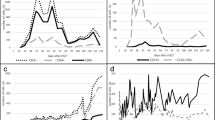Abstract
Background
Allogeneic stem cell transplant is the only curative treatment for Wiskott-Aldrich syndrome.
Case characteristics
18-months-old boy with no sibling, cord blood or matched unrelated donor transplant options.
Outcome
Doing well 7 years after haploidentical stem cell transplantation using unmanipulated bone marrow as the stem cell source.
Message
Father as a haplo-identical donor is a feasible option.
Similar content being viewed by others
References
Sullivan KE, Mullen CA, Blaese RM, Winkelstein JA. A multiinstitutional survey of the Wiskott-Aldrich syndrome. J Pediatr. 1994;125:876–85.
Pai SY, Notarangelo LD. Hematopoietic cell transplantation for Wiskott-Aldrich syndrome: advances in biology and future directions for treatment. Immunol Allergy Clin North Am. 2010;30:179–94.
Suri D, Singh S, Rawat A, Kamaec C, Honma K, Nakagawa N, et al. Clinical profile and genetic basis of Wiskott-Aldrich syndrome at Chandigarh, North India. Asian Pac J Allergy Immunol. 2012;30:71–8.
Munoz A, Olive T, Martinez A, Bureo E, Maldonado MS, de Heredia CD, et al. Allogeneic hemopoietic stem cell transplantation (HSCT) for Wiskott-Aldrich syndrome: a report of the Spanish Working Party for Blood and Marrow Transplantation in Children (GETMON). Pediatr Hematol Oncol. 2007;24:393–402.
Brochstein JA, Gillio AP, Ruggiero M, Kernan NA, Emanuel D, Laver J, et al. Marrow transplantation from human leukocyte antigen-identical or haploidentical donors for correction of Wiskott-Aldrich syndrome. J Pediatr. 1991;119:907–12.
Pai SY, DeMartiis D, Forino C, Cavagnini S, Lanfranchi A, Giliani S, et al. Stem cell transplantation for the Wiskott–Aldrich syndrome: a single-center experience confirms efficacy of matched unrelated donor transplantation. Bone Marrow Transplant. 2006;38:671–9.
Tsuji Y, Imai K, Kajiwara M, Aoki Y, Isoda T, Tomizawa D, et al. Hematopoietic stem cell transplantation for 30 patients with primary immunodeficiency diseases: 20 years experience of a single team. Bone Marrow Transplant. 2006;37:469–77.
Shin CR, Kim MO, Li D, Bleesing JJ, Harris R, Mehta P, et al. Outcomes following hematopoietic cell transplantation for Wiskott–Aldrich syndrome. Bone Marrow Transplant. 2012;47:1428–35.
Stepensky P, Krauss A, Goldstein G, Zaidman I, Elhasid R, Bielorai B, et al. Impact of conditioning on outcome of hematopoietic stem cell transplantation for Wiskott-Aldrich syndrome. J Pediatr Hematol Oncol. 2013;35:e234–8.
Kharya G, Nademi Z, Leahy TR, Dunn J, Barge D, Schulz A, et al. Haploidentical T-cell alpha beta receptor and CD19-depleted stem cell transplant for Wiskott-Aldrich syndrome. J Allergy Clin Immunol. 2014;134:1199.
Author information
Authors and Affiliations
Corresponding author
Rights and permissions
About this article
Cite this article
John, M.J., Philip, C.C., Mathew, A. et al. Un-manipulated haploidentical transplant in Wiskott-Aldrich syndrome. Indian Pediatr 54, 327–328 (2017). https://doi.org/10.1007/s13312-017-1097-z
Received:
Revised:
Accepted:
Published:
Issue Date:
DOI: https://doi.org/10.1007/s13312-017-1097-z




